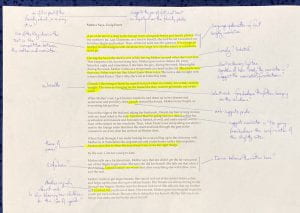
In this post, we will examine the structure of an EFFECTIVE body paragraph and how we can explicitly link our THESIS STATEMENT to a clear TOPIC SENTENCE.
Reminder of the Question
Discuss the representations of individuals or groups in at least one text you have studied has challenged or reinforced your understanding of a social issue.
Reminder of the THESIS STATEMENT from our Introduction
‘Of Mice and Men is a powerful text which tells of the trauma of racial segregation, which invites a contemporary reader to conclude our world still has progress to make in our journey towards racial equality.’
Body Paragraph Structure
- Topic sentence- this should logically extend from the thesis statement and develop your argument in a clear and explicit manner.
- Evidence- what quotations are you going to use to develop/prove your argument?
- Why is this evidence significant/important and how does it support your argument? What does it show? How?
- Link sentence which concludes the paragraph.
Sample Body Paragraph
It is primarily through the character of Crooks, the stable buck on the ranch, that Steinbeck is able to construct the voice of a marginalised black man. In Chapter Four, a reader is invited to see the depth of racial segregation in 1930s America. Alone in his room, his peace is shattered by the entrance of Lennie who asks Crooks why he isn’t ‘wanted’ in the bunkhouse, to live alongside the other men. It is Lennie’s childlike naivety which prompts Crooks to say that he ‘can’t play’ cards with the other men on account of his race. The emotiveless manner in which Crooks states this is confronting to a reader, who can clearly see the marginalisation of his life and the normalisation of his lived experience. As the conversation progresses, Crooks reveals something of his own childhood and how he became gradually aware of his own voicelessness. He remarks that if he says anything, that it is ‘just’ a black person saying it. Steinbeck’s use of ‘just’ as an adjective is revealing here because it shows how aware Crooks is of his lack of agency. Through the voice of Crooks, Steinbeck invites a contemporary reader to see the extent of both racial segregation and the marginalisation of black people.
Teaching and Learning Points
- I need you to look at the THESIS STATEMENT and the TOPIC SENTENCE and understand how they work together to establish a clear and explicit/logical argument.
- The TOPIC SENTENCE should logically extend the argument from the THESIS STATEMENT.
- Is the EVIDENCE given in the body paragraph relevant to the TOPIC SENTENCE?
- Is there an understanding of specific textual features? (voice, adjectives)
- Is there a personal engagement with the text that EXPLAINS the significance of the EVIDENCE?
- Is there a limit to the amount of plot/character summary?
- Does the final (LINK) sentence summarise the argument in the body paragraph?
Here is an annotated copy of the paragraph above with the TEEL structure written clearly on it.

Please make sure you understand the teaching and learning points from this lesson and that you practice them with your own body paragraphs.
Check in with your teacher to make sure you have consolidated this understanding.








